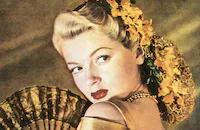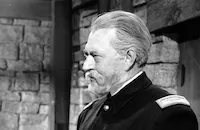Madame X

Brief Synopsis
Cast & Crew
David Lowell Rich
Lana Turner
John Forsythe
Ricardo Montalban
Burgess Meredith
John Van Dreelen
Film Details
Technical Specs

Synopsis
Wealthy and politically ambitious Clay Anderson brings his bride, Holly, home to the family mansion, where she is met by Estelle, her mother-in-law. The marriage is a happy one, with Holly devoting most of her time to their son. Soon, however, Clay's ambition and frequent absences cause Holly to feel neglected, and she begins to date Phil Benton, a bachelor. Estelle, who has hired a detective to follow Holly, demands the end to the relationship; and at the time of their separation, it happens that Phil falls down the stairs in his flat and dies. Panic-stricken, Holly flees and seeks Estelle's help. Estelle then reveals that she never thought Holly good enough for her son and presents her with the alternatives: either ruin Clay's career by facing a court trial, or disappear. Holly goes abroad with a pension provided by Estelle. Falling ill in Denmark, Holly receives help from Christian Torben, a concert pianist. He falls in love with her, but Holly is unable to accept him or explain her situation and so runs away. Twenty years later, while in Mexico, Holly, now an absinthe addict, meets Dan Sullivan, a con man, who, after finding out about Holly's past, plans to blackmail the Anderson family. To prevent this crime, Holly shoots Dan and calls the police. Refusing to reveal her identity, Holly now calls herself Madame X, and upon discovering that her young lawyer is her own son, she becomes more determined than ever to keep her identity secret and readily accepts the prospect of punishment. Clay, Sr., is present at the trial and becomes suspicious of the true identity of his son's client; but Holly dies of heart failure before the verdict is rendered, knowing that she truly has a fine son.

Director
David Lowell Rich
Cast

Lana Turner

John Forsythe

Ricardo Montalban

Burgess Meredith
John Van Dreelen

Virginia Grey

Constance Bennett

Keir Dullea
Teddy Quinn

Warren Stevens

Carl Benton Reid
Frank Maxwell

Karen Verne
Joe De Santis
Frank Marth
Bing Russell
Teno Pollick
Jeff Burton
Jill Jackson
Crew
Betty Abbott
Del Armstrong
Chick Bourland
Richard Bracken
Howard Bristol
Milton Carruth
Charles Chrisman
Charles Cowie
Don Cunliffe
Larry Germain
Joseph Gershenson
Alexander Golitzen
Victor Goode
Douglas Green
Ledger Haddow
Mary Hadley
Walter Hammond
Jean Holloway
Ross Hunter
Tony Lombardo
Jean Louis
Jerry Macdonald
Kathleen Mccandless
John Mccarthy Jr.
Russell Metty
John Morrison
Edward Muhl
Max Nippell
Ed Pyle
Kay Reed
Charles Scott Jr.
Clarence Self
Frank Skinner
Ken Smith
Al St. Hilaire
Tom Tuttle
Waldon O. Watson
George Webb
Bud Westmore
Charles Wildman
Helen Young

Photo Collections
Videos
Trailer


Hosted Intro
Film Details
Technical Specs

Articles
Madame X (1966)
Turner plays Holly, the neglected wife of a diplomat and mother of a young son. She has an affair with a playboy, and is implicated in his death. To avoid tainting her family with scandal, Holly disappears, leaving them to believe she's dead. Over the years Holly sinks into a life of degradation, until another death leaves her on trial for murder...defended by the son who's unaware of who she is.
By the mid-1950's, Lana Turner had segued from sexpot roles into romantic melodramas such as Peyton Place (1957), which earned her an Oscar nomination for Best Actress. The real-life melodrama of her mobster lover's murder by her daughter (Cheryl Crane) not only increased Turner's notoriety, but also her popularity. She then teamed up with director Douglas Sirk and producer Ross Hunter, who specialized in lavishly-produced women's pictures, for Imitation of Life (1959), a tearjerker about a conflicted mother-daughter relationship. It was a huge hit and was quickly followed by another, equally glossy Turner and Hunter collaboration, Portrait in Black (1960).
In 1962, Turner, who had her own production company, bought the rights to Madame X from MGM and entered into a co-production deal with Ross Hunter. But from the start it was a troubled film. It took three years for Hunter and writer Jean Holloway to come up with a script, and even then, it seemed corny and old-fashioned. Hunter approached Douglas Sirk to direct, but Sirk in poor health was unable to accept. David Lowell Rich, a television director, was hired instead. By the time Madame X went before the cameras in 1965, the 45-year old Turner was faced with a role that would not only make enormous demands on her acting skill, but would have her aging from 30 to 55.
All went well during the filming of the early scenes, when Holly is a young and glamorous woman, in a Jean Louis wardrobe and jewels galore. But as Holly deteriorated, so did Turner's spirits. Already self-conscious about aging, she dreaded the unflattering makeup, and feuded with her longtime makeup man and friend, Del Armstrong. "When I thought he'd made me look horrible enough, he said 'You ain't seen nothing yet,' and he meant it. I mean, I've had some bad mornings in my time, but I've never looked like that." Turner insisted on wearing a veil going to and from the set. Columnist Sheilah Graham made matters worse when she visited the set and reported that Constance Bennett, who played Turner's mother-in-law and was in her late fifties, looked younger than Lana...who wasn't wearing her old-age makeup that day.
Turner even fought with Ross Hunter, a courtly man known for the deference with which he treated his aging divas. Exasperated by the delays for which he blamed Turner, Hunter stomped off the set and did not speak to the star for the rest of the picture. Both later denied a feud, and Turner took out an ad in trade papers thanking Hunter and the cast and crew for helping her get through a difficult role.
Although some critics sniped that Madame X was hopelessly old-fashioned, others praised the film, and Turner's performance. James Powers wrote in the Hollywood Reporter, "a superb cast of players take this rather shabby old piece and give it immediacy, vigor and credibility." And Charles Champlin wrote in the Los Angeles Times, "the unsparing, guileless honesty of [Turner's] performance is very touching." Those who called the film passé may have been right - Madame X did not do well at the box office. But it remained among Lana Turner's personal favorites, and one of the performances of which she was proudest.
Director: David Lowell Rich
Producer: Ross Hunter
Screenplay: Jean Holloway, based on the play by Alexandre Bisson
Editor: Milton Carruth
Cinematography: Russell Metty
Art Direction: Alexander Golitzen and George Webb
Costume Design: Jean Louis
Music: Frank Skinner
Cast: Lana Turner (Holly Parker), John Forsythe (Clay Anderson), Ricardo Montalban (Phil Benton), Burgess Meredith (Dan Sullivan), Constance Bennett (Estelle Anderson), Keir Dullea (Clay Anderson, Jr.).
C-101m. Closed captioning.
by Margarita Landazuri

Madame X (1966)
Quotes
Trivia
Notes
Previously filmed by Metro-Goldwyn-Mayer in 1920, 1929, and 1937.

Miscellaneous Notes
Released in United States 1966
Constance Bennett's last film.
Released in United States 1966














